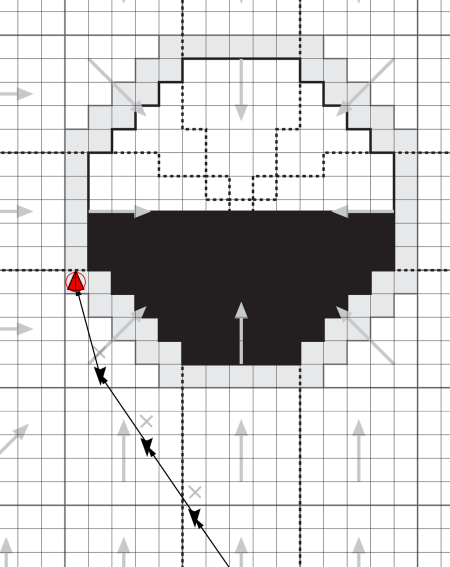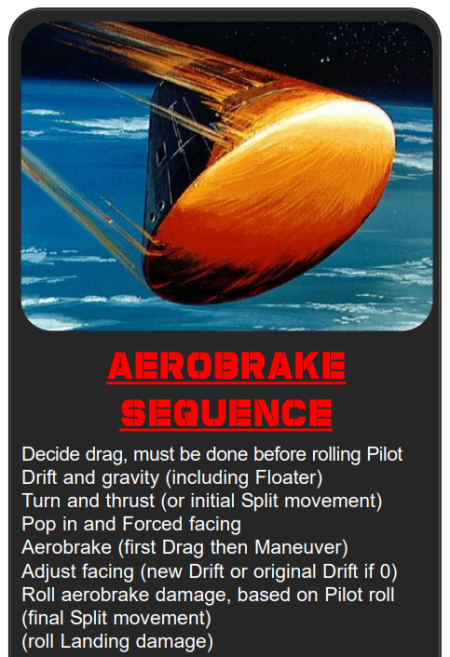Dangers of skimming they say, bah!
Sure, there are dangers, plenty of ’em too. Flying inside a gas giant’s vast gravity field isn’t dangerous per se, you can orbit them forever with no danger of being sucked in, the problem is that in order to skim hydrogen we must dip into the atmosphere and have it slow us down. Speed is what keep us from falling into the gas giant and we are intentionally slowing down while being as close to its crushing atmosphere as possible.
So, we dip in as deep as we dare and let the atmosphere slow us while our scoops gulp in as much gas as possible. Then we thrust away building up speed again to avoid the huge planets cold embrace. Some make one high speed approach and hard braking, others make a series of gentler dips instead, spreading out the danger. System Defense Boats and other daredevils sometimes even slow their ships down to zero deep within the atmosphere, hovering using their grav floaters and slowly scooping gas. No matter how you go about it the risks are real and minor damage to the hull is common.
As if the skimming itself wasn’t hard enough, there is also the real risk of pirate scum picking on us when we are the most vulnerable, they are rare but they do exist.
So there should be no surprise when I tell you that we do not skim that often. The time to enter and exit the huge gravity wells of gas giants offset the cost of getting fuel for free, time is money you see, especially as you must also pay for any hull damage inflicted by the skim.
So there you go, the dangers of skimming are real but not what you think!
Gas giant maps
Gas giants are, as is evident by their very moniker, huge. They are so large so they need special maps when used where the planet take up a large chunk of the map and their gravity field cover the rest of the map. Map sheets for small and large gas giants are available in the InterceptBundle here.
There is the possibility to use the Large scale rules on pages 34-35 and use the large planet maps for large gas giants and small planet maps for the small gas giants. This won’t be covered here though, just make sure you take the scale changes into account as outlined by the rules there.
Approach
Let us say we ha a streamlined ship with 1G of thrust, a Size of 8 (100 dTon) and a Pilot skill of 2, the computer is a model 1 giving us just 1D6 dice pool. The Pilot defaults table will give us 3(Miss) for 3 steps of turning every turn and the task result will be treated as a Miss. We will use the Pilot default on our approach flight but for the aerobrake turn we’ll dare an actual Pilot task roll trying to get a better result as the damage roll depends heavily on our Pilot task result.
The ship will fly towards the gas giant ass first, brake-thrusting to keep the speed from becoming too large from gravity – maximum safe speed/drag is 4/2 for airframes and 2/1 for streamlined. Keep those numbers in mind as you approach the gas giant. Try to hit the atmosphere edge on rather than head on when entering the voluntary aerobrake squares (the light grey area bordering the planet), also make sure that your ship face in the direction it will be going to head in the next turn.

The ship in the picture is thrusting to negate gravity (each x show where it would be if it drifted that turn). In the last turn it drifted and let gravity pull it into the voluntary aerobrake zone and speed it up to a speed of 4 (4.5rounded down). The circle around the ship show that it is drifting
The next turn we’ll go through aerobrake skimming step-by-step so please pay attention. This is a good moment to tell your crew over the intercom to buckle up, things can get bumpy.
Aerobrake skimming

We’ll follow the steps from page 25 of the rulebook in some detail here, don’t worry though as it is much easier in practice. Print out a mapsheet and doodle away.
Decide drag and determine Pilot task result
Decide drag, then roll Pilot or use Pilot default to determine the level of success and the amount of turning available this crucial turn. Rolling the Pilot task will give you a better result on the average but with the Pilot default table you know what you get. We are moving at a speed of 4 and have decided to use 2 drag to stay in the 5-6 column of the Aerobrake DAM table, more on that later.
After deciding drag we will determine our Pilot task result. Pilot default has given us 3(Miss) for all of the turns of our approach but we will try to roll the Pilot task for the aerobrake hoping to get at least a Fair result, aerobrake damage depend heavily on the Pilot task result and a Miss is just not good enough we think. Rolling may give us worse than Miss of course but we bet that fortune smiles upon us. The ship is Size 8 and our Pilot skill is 2 with 1D6 dice pool so we roll 3D6 and pick the two highest and add 2.
Pilot task is rolled against the ships Size of 8 so we roll 1, 3 and 3 and use the two 3s for a die roll of 6 with 2 added, 8 – we just barely managed to roll a Fair result! This will give us 4 steps of turning but more importantly our damage roll will be based on a Fair result instead of a Miss, more on that later.
Drift and gravity (including Floater)

Gravity will take us back into the voluntary aerobrake zone again and our speed is still 4. Let’s zoon in a bit so we can see clearer.

Turn and thrust (or Initial Split-movement)
Typically you’ll only turn here, to face in your drift direction but nothing stops you from thrusting too, you may even do the first half of Split-movement here, go crazy but don’t forget that if you hit the planet you are dead. Our facing and vector are actually perfect so we’ll leave the ship as is here.
Pop-in and Forced facing
Now the ship pop in its surface fixtures which means that Visual, IR and Radar cannot Scan later in the turn, you do get to keep your Tracked targets and any launched missiles. We’ll pop in and hope that no coward pirate sneak up on us, for new targets we’ll be completely blind this turn.
Our ship is facing in the direction of our vector so there will be no Forced facing. Try to avoid this forced facing adjustment as it will increase the risk of damage quite a lot (your ships hull will be treated as one degree worse if adjusted here.
Aerobrake (first drag and then maneuver)

We decided on a drag of 2 two so let’s do them. We will simply move the drift two squares, one at a time. In our case there are no choices but sometimes there will be two options (zag-zig or zig-zag) and the Pilot can decide which one that is preferable as long as each step moves the drift closer (and thus reducing speed).

The ship has no wings and we didn’t adjust facing so there is no Maneuver to do. If we had some maneuver to use it would still be limited by the drag used (in this case 2), so maneuver could move the drift after aerobrake up to 2 in any direction. We have zero maneuver but if not we could maneuver to any square that wasn’t greyed out in the picture. Note that brake Gs are determined by counting the squares from our position before the aerobrake to the position after drag and maneuver.
Adjust facing
Our ship is still facing in the direction of our vector so no final facing adjustment is needed, this is mostly happening when a ship also uses Maneuver. This final adjustment of facing does not affect damage, it simply turns the ship to face the direction of travel.
Roll aerobrake damage

We came in with a speed of 4 and our aerobrake took us 2 squares from that so our brake is 2. We’ll use the 5-6 column as 4 + 2 = 6. Our ship was Streamlined so our aerobrake DAM is 3. Now it’s time to roll the actual damage.

Our Pilot task roll was Fair from the Decide drag and Pilot task step and the table tell us a Fair result will be rolled using 2D6 and picking the lowest and that the location of any damage is Hull.
We roll a 2 and a 5 and use the lowest one so 2 it is. Add 2 to the 3 we got from the aerobrake DAM table, 5 on the damage table is (Scratch), one point shy of Light damage. Some scorched paint and scratches is all we got from the aerobrake, let’s get out of here!
Skimming fuel
- Skimming will net speed x brake x 5% of its hull per 15 min
- Hovering will net 1.25% of its hull volume per 15 min
The ship did an aerobrake of speed 4 and drag 2 which give us 4 x 2 x 5% = 40% of the ships hull volume skimmed. This is probably far more than the actual tankage we got so we leave the gas giant with full tanks and some scratches on the hull for our efforts.
Hover skimming
Hover skimming using Floater will be dealt with in a future post, stay tuned!
Large scale maps
Skimming can also be done using the 100 000 km per square, 1 hour per turn scale. In this scale large gas giants use the large planet maps and small gas giants use small planet maps. This will also be dealt with in a future post so stay tuned for that too!
So, to finish off my diatribe about the dangers of skimming by saying that the subs, the subsidized merchant crews are the bravest and here’s why:
A fully loaded sub has enough fuel for 4 hours of continuous 1G thrust! You normally use less than half of that to get to the jump point, which means that you have a bit more than half to maneuver towards the gas giant. What is even worse is that when fully loaded a sub’s Floater is only capable of negating about 60% of gravity, yeah, that is why they have those wings; to assist in takeoff when the Floater alone cannot do the job, and these guys sure need to turn every dime as their sponsors take half of what they earn.
I dare you to find a single subs skipper that has ever skimmed a gas giant fully loaded!